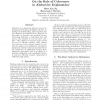Free Online Productivity Tools
i2Speak
i2Symbol
i2OCR
iTex2Img
iWeb2Print
iWeb2Shot
i2Type
iPdf2Split
iPdf2Merge
i2Bopomofo
i2Arabic
i2Style
i2Image
i2PDF
iLatex2Rtf
Sci2ools
AAAI
1990
1990
On the Role of Coherence in Abductive Explanation
Abduction is an important inference process underlying much of human intelligent activities, including text understanding, plan recognition, disease diagnosis, and physical device diagnosis. In this paper, we describe some problems encountered using abduction to understand text, and present some solutions to overcome these problems. The solutions we propose center around the use of a dierent criterion, called explanatory coherence, as the primary measure to evaluate the quality of an explanation. In addition, explanatory coherence plays an important role in the construction of explanations, both in determining the appropriate level of speci
city of a preferred explanation, and in guiding the heuristic search to eciently compute explanations of suciently high quality.
AAAI 1990 | Explanatory Coherence | Important Inference Process | Intelligent Agents | Physical Device Diagnosis |
| Added | 06 Nov 2010 |
| Updated | 06 Nov 2010 |
| Type | Conference |
| Year | 1990 |
| Where | AAAI |
| Authors | Hwee Tou Ng, Raymond J. Mooney |
Comments (0)

